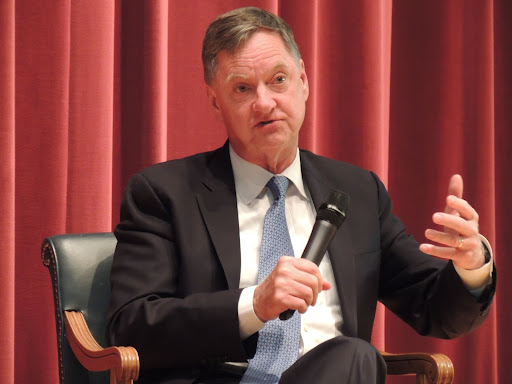Chicago Fed president forecasts second-half growth, little risk of recession as inflation dips in July

Michael Crumb Aug 11, 2022 | 4:03 pm
5 min read time
1,086 wordsAll Latest News, Economic DevelopmentThe nation’s economy will likely grow in the second half of 2022, Charles Evans, the president of the Federal Reserve Bank of Chicago, said during an event at Drake University on Wednesday, the same day a report showed inflation had dipped to 8.5%.
Evans, who spoke during an economic update sponsored by Drake University and the Greater Des Moines Partnership, also said the risk of the economy falling into recession was low.
He participated in a question and answer session moderated by Robert Palmer, a member of the Chicago Federal Reserve Bank of Chicago Advisory Council and general counsel to the Iowa League of Cities. The event, held in Drake University’s Sheslow Auditorium, also included an opportunity for audience members to ask questions.
Evans has held his current position since 2007. Before becoming president, he was director of research and senior vice president, supervising the bank’s research on monetary policy, banking, financial markets and regional economic conditions.
On Wednesday morning, the latest Consumer Price Index report was released showing inflation declined in July to 8.5%, from 9.1% in June and lower than the 8.6% of May. Evans said it’s a small sign that efforts the Fed is taking to bring inflation under control may be working.
“It’s better than the report last month and the month before, so we’re getting the first positive report that the headline level prices are flat,” Evans said.
He said he expects that the Federal Reserve will continue to increase rates the rest of this year and into 2023 in an effort to get inflation back to 2%. The Federal Reserve increased rates by 0.75% on July 27, its latest increase this year in an effort to bring inflation down.
“I’m optimistically forecasting into next year the core array of PCE inflation is going to be something closer to 2.5%.That will be above our 2% objective, but it will be substantially lower than where we are now,” Evans said in his opening remarks.
Core PCE inflation is the measure of prices people pay for goods and services, not including food and energy, which are more susceptible to price swings.
Evans said he does not believe the country is in a recession. He also doesn’t believe it’s likely a recession will occur.
“I’m not looking for the economy to turn down in any significant fashion, so I’m not looking for recession,” he said. “For the second half of this year we should see positive growth. We have seen cooling household spending, retail sales have been slowing, the housing market has turned down. We’ve increased interest rates and markets are expecting further increases in interest rates. There is a lot of uncertainty that businesses are navigating, and when that’s the case they’re usually cautious about expanding their operations.”
Evans said those were some of the reasons growth was flat or negative in the first half of the year, referring to the two previous gross domestic product reports.
“But I don’t think that’s indicative of a recession,” he said. “Recessions are usually things that are a surprise. Something happens and then all of a sudden the economy turns down.”
He also pointed to last month’s jobs report, which showed 528,000 jobs were created in July and unemployment was low.
“It is surely the case that the economy is a little more fragile at this point … but I think it would take something adverse to take us in a downturn. … The fundamentals continue to be pretty good,” Evans said.
He said supply chain issues continue to be a challenge, and that the “just-in-time production inventory model just doesn’t seem to be working as well under current conditions as it does for a long period of time.”
He said it’s more challenging for businesses to move toward a “buffer-stock” inventory.
Other risks to the economy are the ongoing war in Ukraine, geopolitical risks and ongoing workforce issues in the U.S., Evans said.
He said it’s uncertain whether the labor force issues will be resolved in the next couple of years.
“There’s millions and millions of more vacancies out there than available, unemployed workers, and the question that comes to mind of economists is how do you reduce that number of vacancies without the unemployment rate going up a lot,” Evans said.
He said the economy is in a “very unusual situation,” with the sharp downturn at the onset of COVID-19 followed by a sharp recovery, which he said is not “normal monetary policy.”
Evans said it’s possible that the Fed’s monetary policy can be tightened enough to lower inflation, but that unemployment will likely go up to about 4.25%, which he said is a more sustainable number.
Usually, if unemployment is low, actions can be taken to knock it up a little, but if inflation is also low, taking action on unemployment wouldn’t make sense, Evans said.
“Why would anyone want to get in the way of the economy or when American households are doing well?” he said. “But when inflation is high, then that’s a problem.”
“So other things are reordered and vacancies are just part of that,” Evans said. “I think that adjustment process could likely be just very different from anything else we’ve experienced.”
He said he expects that there are people who have just not returned from the COVID shutdown, or that there could be child care and adult care issues. Then there is the aging workforce, which makes things more challenging, Evans said.
One question from the audience was about equity and whether the Federal Reserve can drive benefits to those on the bottom of the economic ladder rather to those at the top.
Evans said the Federal Reserve should look broadly at how its policies affect everybody.
Congress has tasked the Federal Reserve with promoting maximum employment, stable prices and moderate, long-term interest rates.
“We should be cautious not to provoke an unnecessary economic restraint unless it’s really essential to maintain price stability,” Evans said. “We’re in a current situation where there is 8.5% inflation; we really need to get on top of that. So I think we should do it in a measured and appropriate way, but we have to make sure that we can reestablish price stability before too long. Monetary policy is really only one tool. If I had five tools I might be able to get a particular income distribution a little bit more. We need other policies, so policymakers should come together and think about what’s good for the economy.”
Photo by Michael Crumb.

Michael Crumb
Michael Crumb is a senior staff writer at Business Record. He covers real estate and development and transportation.











